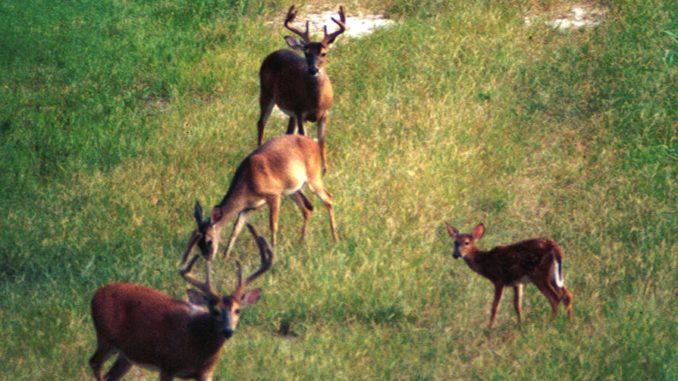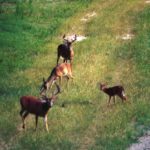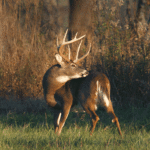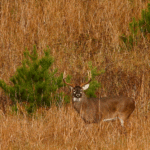
Give late-season bucks some space and you’ll get more opportunities as the season draws to a close.
There’s a lot of ways to kill a deer in South Carolina, from up close and personal with a bow to in front of dogs that scatter deer from almost impenetrable cover. Then, in some sections of the state, there’s the tried and true method of hunting from a stand over bait, usually at a respectable distance for a hunter.
While all of these will work late in the season, another strategy is overlooked by many hunters: long-range hunting. According to several expert hunters, long-range hunting is ideal for taking big deer anytime, but perhaps especially late-season.
As is the case with any tactic, some hunters take it to the extreme and shoot from extremely long distances — the opposite of hunters who set up at 100 yards or less and limit their late-season opportunities. These experts give advice that will enable many to feel comfortable at distances of 150 to 300 yards — sometimes longer.
One well-known South Carolina deer hunter is Laurens County’s Joe Kelly. Very popular as a speaker at outdoors shows and seminars, he has long extolled long-range hunting tactics as among his favorites late in the season.
“It’s unfortunate that a lot of hunters don’t hunt late in the season, because they’re missing a great opportunity to kill a big buck,” Kelly said. “The rut is certainly a great time, but I’ve found late season can be excellent, especially if a hunter has the land access to set up for long-range hunting. Bucks can be patterned, and setting up for long-range hunting is the ideal way to get them.
“After the rut, deer simply change their habits and patterns,” Kelly said. “Deer change patterns for reasons, and hunters have to figure out what’s going on in their specific neck of the woods. What deer do in the Lowcountry may be different than what occurs in the Piedmont and mountains, but it can be overcome by some scouting and planning.”
One tactic that works well in many areas, especially when cold weather really sets in, is hunting thick, heavy cover.
Kelly loves to hunt regenerated pine stands that range from three to seven years of age. Their re-growth offers prime cover for big bucks, but to see long distances in these areas he has to use a climbing stand and climb high. He said new cutover areas, as well as food plots, can be good and hunted from a normal, permanent stand, but long-distance shooting is likely required to be successful.
“The first key is to be able to see a large area, which often means making a major change in your hunting strategy from earlier in the season,” Kelly said. “Then, set up a stand or use a climber to get into position depending on the terrain hunted.
“In the lower part of the state, there are lots of agriculture crop fields where deer will be feeding, and shots of 200 yards to as far as a person is comfortable shooting are possible,” he said. “In the (Midlands) and Piedmont area where I hunt a lot, I love to hunt cutover areas, but my set-up will be such that I may have a shot for 150 to 300 yards or more in these situations. In the rugged Upstate country, a hunter may shoot across a valley from one ridge to another after the leaves fall if they set up properly. The point is, there potential for long-range shooting and taking big deer is unlimited if a person is willing to do the work. A hunter must ensure they hunt areas where they can see long distances in areas that have deer late in the season. Then they must be able to accurately make a long shot and have the patience to hunt in this manner.”
Kelly said long-range hunting can be made to work in several different ways. Among them include the obvious of being able to accurately shoot a long distance, but there’s much more to it than that.
“When the leaves fall, regardless of where you hunt, you simply can see further,” Kelly said. “Stand selection is crucial so you can see deer close as well as far off. When I see a deer at 250 yards slipping through a cutover area I have several things already working in my favor.
“First, while I am always aware of the wind speed and direction, the potential of scent giving me away is significantly reduced the further I am from the deer,” he said. “I still take all normal measures to ensure I am as scent-free as possible in case that monster bucks walks close to me downwind. But at 200 plus yards, I seldom have to worry about scent. I’m also usually high in a climbing stand, which affords me a good view of the overall area. I love to hunt a cutover area where the growth is as high or higher than a deer’s head. A big buck feels safe and will walk more freely, even in mid-day. Climbing high enables me to see deer in thickets or slipping through a narrow funnel of hardwoods when the leaves have fallen.”
Chuck Porter of Sumter is another hunter who enjoys long-range hunting. He hunts large, open fields, power-line right-of-ways and food plots planted to attract deer.
“After the rut, deer will focus on specific areas, and often, they will slip along edges of a big field,” Porter said. “Power lines are great areas to see deer crossing if you set up in a stand where you can see and shoot long distances. The first long-range buck I killed was at 315 yards on a power line. One key is constant scanning with binoculars to see a deer at the first opportunity, and (another is to) have a good rest to steady the gun. Regardless of how steady you are, a good rest is crucial for consistently making long shots.
“Another good tactic is to hunt from a stand overlooking an agriculture field in late season,” he said. “Deer will often still check out these food sources, and in the Lowcountry, a cut cornfield legally baited with corn about 200 to 250 yards from the stand is a great plan for long-range hunting. While wind, minimal movement and scent control are strong considerations, generally deer feel safe at those distances. I’ve learned that by backing off to a long distance I am going to see more deer than if my stand is only 75 to 100 yards away. This is actually compounded late in the season when deer have been hunted hard. Back off and you resolve that issue. But you’ve got to have a flat-shooting rifle and be able to make a good shot.”
One thing Kelly employs is a climbing stand, saying it is a key to success for his style of hunting.
“Climbing stands enable a hunter to adapt (and) change deer hunting locations quickly,” he said. “Late-season deer often have to change patterns to find ample food. When they do, an area that has deer one day many not have many or any a few days later. I have to stay on the move to keep up with deer. Climbing stands help me accomplish this, plus, I can select stand sites where I can see long distances, and by covering more territory I can find deer.”
Kelly said patience is also a key. Late-season hunting can mean low-light movement times for deer, but he also sees a lot of deer during the mid-morning after the sun gets up.
“I love to hunt on a cold morning with a lot of frost,” he said. “But I know that on those mornings, it may be well up into the day before I see deer. Once the sun rises, deer will often begin to move in cold weather. If a hunter has the patience to hunt until mid-day and uses their binoculars constantly to scan edge lines, thickets and across open fields, odds are good they’ll see deer moving. It can be tough to sit in that early morning cold, but it’s usually worth it. I recommend a hunter get to the stand early, be quiet, wait and watch. Odds are good you’ll be rewarded with seeing deer — often lots of deer.”
Successful long-range, late-season hunting opens a lot of opportunities for deer hunters. The keys are finding the right locations and be willing to move to find deer, use optics to your advantage and be able to make that long when the opportunity occurs.
The record book kept by the S.C. Department of Natural Resources confirms that numerous trophy bucks have been taken in December. One of the best ways to outsmart a wary buck is to figure his movement pattern and set up at a long distance. If you do your job right, according to these experts, he’ll never know what hit him.
Whether you are looking to put venison in the freezer or a trophy rack over the mantle, late season, long-range hunting offers a great opportunity.







Be the first to comment